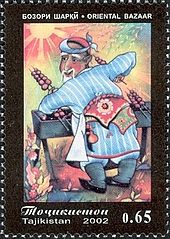Shashlik
 | |
| Course | Main course |
|---|---|
| Serving temperature | Hot |
| Main ingredients | Meat, marinade, onions |
Shashlik, or shashlyck (Russian: шашлык shashlykⓘ), is a dish of skewered and grilled cubes of meat, similar to or synonymous with shish kebab. It is known traditionally by various other names in the Caucasus, Eastern Europe and Central Asia,[1][2] and from the 19th century became popular as shashlik across much of the Russian Empire and nowadays in the Russian Federation and former Soviet Union republics.[3][4][5]
Etymology and history
The word shashlik or shashlick entered English from the
Preparation


Shashlik was originally made of
While it is not unusual to see shashlik today listed on the menu of restaurants, it is more commonly sold in many areas in the form of fast food by street vendors who roast the skewers on a mangal over wood, charcoal, or coal. It is also cooked in outdoor environments during social gatherings, similarly to barbecue in English-speaking countries.
Despite the simplicity of preparing shashlik, the process of frying meat over an open fire can cause inconvenience for residents of apartment buildings.[13]
See also
References
- ^ ISBN 5-9524-0718-8.
- ^ a b c Culture and Life. Union of Soviet Societies for Friendship and Cultural Relations with Foreign Countries. 1982 – via Google Books.
The Russian term, shashlik, has an interesting etymology: it would seem natural for the word to be borrowed from one of the Caucasian languages. But no, the Georgian for it is mtsvadi, the Azerbaijani, kebab, and the Armenian, horovts. Shashlik is a Zaporozhye Cossack coinage from the Crimean Tatar sheesh (spit), brought to Russia in the 18th century, after Field-Marshal Mienich's Crimean campaign. Prior to the 18th century, the dish was called verchenoye, from the Russian vertel, spit.
- ^ ISBN 9781598849554– via Google Books.
An ancient dish, well known to herders and nomads across a wide swath of the Caucasus and Central Asia, shashlyk became popular in Russia in the mid-19th century after Georgia, Azerbaijan, and part of Armenia were absorbed into the Russian Empire. In those regions, shashlyk originally referred to cubes of grilled lamb cooked on skewers, whereas basturma was the grilled beef version of this dish. But Russians have broadened the term shashlyk to mean any kind of meat–pork, beef, lamb, venison–cut into cubes, marinated for several hours, threaded onto skewers, and cooked over hot coals.
- ISBN 9780191040726– via Google Books.
- ISBN 9780313376269– via Google Books.
- ^ American Heritage Dictionary Entry: shashlik
- ^ "Vasmer's Etymological Dictionary". starling.rinet.ru. Archived from the original on 16 January 2008. Retrieved 10 May 2017.
- ^ Владимир Гиляровский. Москва и москвичи, гл. Трактиры. 1926 (Vladimir Gilyarovsky. Moscow and Muscovites. 1926)
- , Culinary Dictionary. Moscow, Tsentrpoligraf, 2000; Russian)
- ^ "Archived copy". Archived from the original on 2013-10-12. Retrieved 2013-10-12.
{{cite web}}: CS1 maint: archived copy as title (link) - ^ "از شیشلیک شاندیز تا آبگوشت مشهد". Archived from the original on 2013-10-12. Retrieved 2013-10-12.
- ^ Marinade recipes for shashlik at RusslandJournal.de
- ^ Eremeeva, Jennifer (2020-05-30). "Shashlyk in the City". The Moscow Times. Retrieved 2024-03-12.


